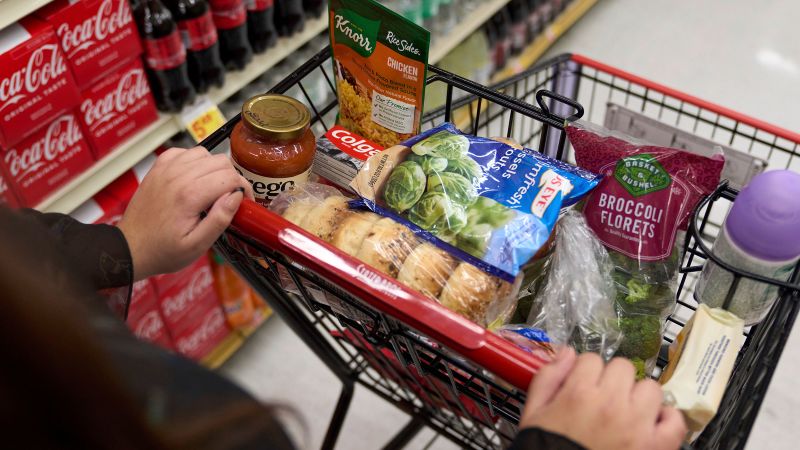Roughly 42 million people are at risk of losing critical food assistance in November amid the federal government shutdown. And it’s not clear whether the Trump administration will step in to find the funds to continue paying benefits, as it has with other priorities.
The food stamp program will run out of money in two weeks, Agriculture Secretary Brooke Rollins told reporters at the White House on Thursday.
“So you’re talking about millions and millions of vulnerable families, of hungry families that are not going to have access to these programs because of this shutdown,” she said.
Like other members of the Trump administration, Rollins cast blame on the Democrats, posting on X Thursday that they are putting “their political agenda ahead of food security for American families.”
Democrats have argued Republicans are at fault for being unwilling to negotiate a spending deal that includes the extension of expiring enhanced Obamacare premium subsidies.
Rollins’ comments came a week after the US Department of Agriculture told states that there is not enough money to pay full food stamp benefits in November if the lapse in federal funding continues. The agency asked states to hold off on November payments until further notice.
About one in eight Americans receive help buying food through the Supplemental Nutrition Assistance Program, or SNAP, the formal name for food stamps. A key pillar of the nation’s safety net, the program provides enrollees with an average monthly benefit of $188 per person, as of May.
The nation’s largest anti-hunger program, SNAP has a contingency fund of about $6 billion, but November benefits are expected to total around $8 billion. The USDA’s shutdown plan noted multi-year contingency funding is available to fund benefits in the event of a lapse.
Asked whether the USDA intends to make at least a partial benefit payment next month, a senior agency official pointed to Rollins’ comments that the program’s funding will be depleted in two weeks.
New York Gov. Kathy Hochul blasted the Trump administration for requiring states to halt the process of issuing monthly benefits.
“This is a deliberate and unprecedented decision intended to inflict pain on millions of hardworking American families — the federal government should instead do everything in its power to prioritize our most vulnerable and make funding available for this critical program,” Hochul, a Democrat, said in a statement Friday.
The food stamp program is the second nutrition assistance lifeline at risk of running out of money amid the ongoing standoff on Capitol Hill between Republicans and Democrats over approving a federal spending package for the current fiscal year. The impasse forced the federal government to shut down on October 1.

Federal worker: Shutdown is ‘taking food off my table’
As the government shutdown stretches into a third week, many federal workers will not receive paychecks if the shutdown continues. CNN’s Rene Marsh speaks with one family who will have to choose between putting food on the table or car payments.

WIC, which provides food aid to nearly 7 million pregnant women, new moms and young children, was on course to deplete its funding earlier this month. But the Trump administration shifted $300 million in tariff revenue that’s typically used to fund child nutrition programs to keep WIC operating. The infusion should be enough to cover benefits for the rest of the month, according to the National WIC Association.
However, there is not enough of that tariff revenue to also shore up the food stamp program for November, a senior USDA official told CNN.
The looming lack of funding is already forcing 17 states to stop accepting new food stamp applications. That’s because their systems would require them to send partial October payments with November’s benefits. Other states are able to separate payments for the two months and can distribute October’s aid to new enrollees.
This is not the first time that food stamps have been at risk during a shutdown. During the record-long impasse that began in December 2018, the USDA initially said benefits would run dry at the end of January. But the agency then said it would use a provision allowing it to make obligated payments within 30 days of a government funding lapse to cover February payments. That workaround ultimately wasn’t needed since the shutdown ended in late January.
Food stamps provide critical assistance to families who need the help to be able to eat, said Gina Plata-Nino, acting director of SNAP at the Food Research & Action Center, an advocacy group.
The November benefits are especially important with Thanksgiving on the horizon, she said. And food pantries can’t fill the gap since they are already under strain.
The administration should act urgently to protect food stamp benefits, as it has done with its other priorities during the impasse, said Ty Jones Cox, vice president of food assistance at the left-leaning Center on Budget and Policy Priorities.
“We can’t let households who need help purchasing food become another casualty of this shutdown,” she said.
Source link




